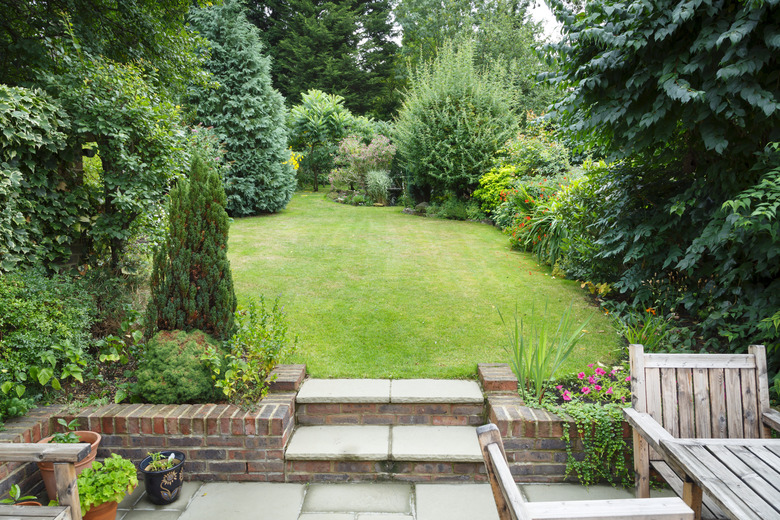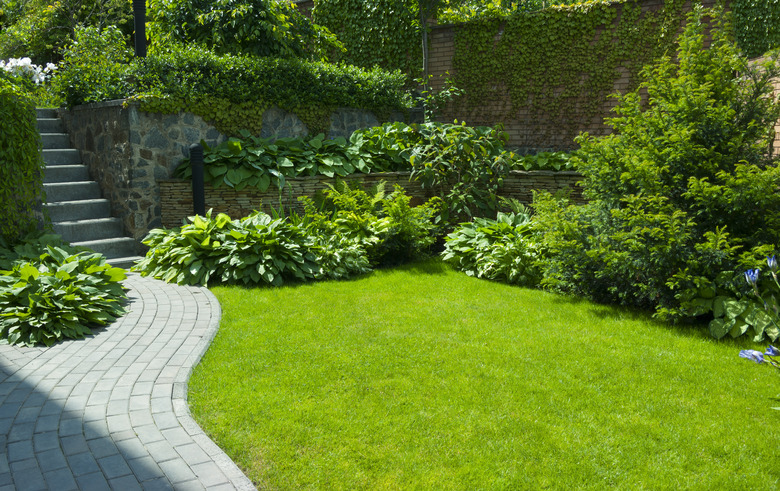A Homeowner's DIY Guide To Lawn Problems And Repairs
We may receive a commission on purchases made from links.
- Lawn Repair for a Sparse Lawn
- Fighting Lawn Weeds
- Identifying and Treating Common Lawn Diseases
- Dealing With Snow Mold
- Identifying and Treating Common Lawn Pests
- Fighting Lawn Grubs
- Filling Bare Patches
- Lawn Repair for a Bumpy, Uneven Lawn
- Dethatching a Lawn
- Topdressing for a Healthier, Fuller Lawn
- Overseeding for a Healthier, Fuller Lawn
For most homeowners, an emerald-green lawn consisting of turfgrass with a billiard-table-smooth surface is the ideal. Achieving this goal can be quite difficult, however, as lawn care requires constant attention and frequent intervention. The reason is that the same conditions that make for great grass growth — lots of water, copious amounts of fertilizer and near-constant sunlight — are also highly favorable to weeds, insects and fungal diseases. Never fear — you can come close to a perfect lawn by routinely practicing a few simple maintenance tasks.
Lawn Repair for a Sparse Lawn
Lawn Repair for a Sparse Lawn
One of the most common complaints is that lawn grass isn't as thick and luxurious as you desire. Most people dream of a lawn that looks like a professional golf course, and nothing else will do. There are many reasons a lawn might underperform:
- Lack of nutrients: Lawn grass requires regular fertilization to maintain its deep-green color. You can reduce fertilizing chores by mowing with a mulching mower that chops up grass clippings to break down and feed the lawn. Most lawns will require at least two feedings yearly with a granular fertilizer. If your lawn is sparse, it may not be getting the nutrients it needs.
- Lack of sunlight: Many people lament a sparse lawn but aren't willing to take steps to ensure it gets the sunlight it needs to thrive. Even grasses selected for shady conditions need a fair amount of sunlight to thrive. If the site doesn't get at least four hours of sun daily, you will be hard-pressed to grow a really nice grass lawn. The solution may require that you trim back or remove shade trees or change to an alternate ground cover that thrives in shade.
- Poor soil: Like most plants, grasses grow best in rich, well-draining soil. Soils that are too sandy and loose or too dense with clay will rarely grow great lawns. The answer is often to amend the soil through regular topdressing with compost or a good-quality topsoil.
- Wrong choice of grass species: Commercial mixes of lawn grass seed are typically blends of several types of grass seed, such as rye grass, Kentucky bluegrass and fescues. Sometimes, these mixes aren't appropriate for your growing zone or specific site conditions. Planting with grass more precisely tailored to your climate can greatly improve your lawn.
It's possible that your location just isn't suitable for traditional grass seed. If you very much like your dense shade trees or your evergreens that create acidic soil conditions, it may be nearly impossible to grow a picture-perfect lawn. Increasingly, homeowners are creating lawns using clover (Trifolium repens, USDA zones 3-10)— which has very low water needs and actually adds nitrogen to the soil— or other ground-cover plants, such as bugleweed, (Ajuga reptans, USDA zones 3-10), pachysandra (Pachysandra spp., USDA zones 5-9) or violets (Viola sororia, USDA zones 3-7). The downside to these turfgrass alternatives is that they're considered invasive plants in some areas; check with your local cooperative extension service to determine their suitability in your yard.
Fighting Lawn Weeds
Fighting Lawn Weeds
Another common complaint is that keeping lawns weed-free is almost impossible. The same conditions that make for good lawn grass also make for good weeds, so you can expect fighting weeds to be an ongoing chore. Many homeowners deal with this by hiring lawn services to dump heavy doses of herbicides on the lawn, but this is a questionable choice environmentally. These herbicides often wash off into lakes and rivers. Spraying an entire lawn with weed killer should be a last resort.
It is much better to deal with lawn weeds on a spot-treating basis, either by spraying individual weeds with a hand sprayer mixed with an appropriate herbicide or by removing the weeds with a mechanical digger or weed popper. If you make this a regular routine after you mow, your lawn will remain surprisingly free of broadleaf weeds and invasive grasses, such as quack grass or crabgrass.
Identifying and Treating Common Lawn Diseases
Identifying and Treating Common Lawn Diseases
Lawns can be susceptible to a variety of diseases caused by various microorganisms, such as fungi, bacteria or even viruses. Fungal diseases are especially prevalent. Some of the most common include:
- Brown patch: This disease causes irregular patches of dead, sunken grass. It occurs most often in humid, wet conditions, especially when a lawn has been excessively fertilized.
- Dollar-spot/leaf-spot disease: These diseases cause smaller patches of dead grass that may spread to create larger dead patches. These diseases are encouraged by wet, humid weather and too much nitrogen in the soil.
- Pythium lawn disease: Small, parasitic microorganisms that are similar to fungi cause a variety of lawn diseases that create thinning patches of grass.
- Rust diseases: These diseases cause yellow specks on grass blades that become rust-red as they age. Grass blades begin to die. The reddish dust may stain shoes and clothes after mowing. Too much shade and too little fertilizer can cause rust disease.
Although less common, bacterial infections can also affect grass. These are usually evidenced by leaf spotting and sometimes plant crowns that turn soft and mushy. Bacterial infections are often a secondary infection that sets in on areas already weakened by more common fungal infections.
Viral infection is also possible with lawns, although this too is less common than fungal infection. St. Augustine decline is a common viral disease that is specific to Southern lawns planted with St. Augustine grass. Causing yellow stippling of the grass blades, the disease is slow growing but almost untreatable. The solution is often to kill off the grass entirely and plant with another species.
Treating most lawn diseases is a matter of keeping grasses healthy through the systematic practice of good lawn care. Lawns that receive the right amount of water, fertilizer and sunlight will generally remain in good health. Preventive practices include:
- Keeping the soil pH at a proper level.
- Fertilizing properly.
- Watering to maintain lawn health.
- Mowing correctly.
- Dethatching and aerating regularly.
- Fighting pest infestations.
Dealing With Snow Mold
Dealing With Snow Mold
Snow mold is an especially prevalent fungal disease affecting lawns under the cover of snow. Pink or gray circular spots up to 1 foot in diameter appear in winter or spring after snow melt. The grass blades often become water-soaked, turn reddish-brown and then turn tan. When sunlight strikes the patch, you will see pinkish threads of fungal material. Snow mold is most likely to strike when fall temperatures have been very cool, and snowfall covers the lawn while it is still damp. Too much nitrogen fertilizer in the fall can also leave the grass vulnerable to snow mold.
There is not much required in the way of treatment. Snow mold naturally disappears as the weather dries. You can take measures to prevent snow mold from reappearing the next fall and winter. Make sure you stop fertilizing at least six weeks before the first expected snow, cut the grass short and remove all leaves and debris that can harbor fungal spores.
Identifying and Treating Common Lawn Pests
Identifying and Treating Common Lawn Pests
Lawns can be subject to several insect and animal pests:
- Chinch bugs: Several species of this tiny insect feed on grass blades. An anticoagulant in the insect's saliva causes grass blades to wilt and die.
- Sod webworms: Webworms are the larval stage of webworm moths. They will eat entire grass plants, leaving dead patches in the lawn. The lawn may also become riddled with holes from birds feeding on the worms.
- Armyworms: These moth larvae feast on grass plants, often skeletonizing the blades. Circular dead patches appear in the lawn. When infestations are heavy, the entire lawn may appear to move as blades of grass wiggle.
- Cutworms: Several species of cutworms can sever grass blades at crown level, leading to dead spots.
- Rodents: Gophers, moles, squirrels and other creatures may dig to feed on the insect pests that are already damaging your lawn. Addressing the insect pests often causes the animal pests to disappear. You can set traps for especially destructive animal pests, such as moles and gophers.
Some insect pests in the lawn can be very difficult to eliminate without chemical pesticides. A biological control, Bacillus thuringiensis, var. kurstaki (Btk), is often effective on caterpillar pests, such as cutworms, armyworms and sod webworms. A variety of granular chemical compounds are available to combat armyworms and other damaging insects. Read label directions carefully and choose the least-toxic product available. Once you identify the type of insect you are battling, your local extension service may have recommendations for organic methods for fighting them. Long term, many insect pests can be prevented with proper lawn care, including regular aeration and dethatching when appropriate.
Fighting Lawn Grubs
Fighting Lawn Grubs
Grubs are the wormlike larvae of several types of winged beetles, including the June bug and Japanese beetle. These larvae hatch underground, where they feed on grass roots before emerging as adults. Symptoms of lawn grubs are spreading patches of dead grass that can be easily lifted from the ground since the roots have been severed. Diagnosing lawn grubs involves removing a patch of lawn and counting the number of grub larvae in the soil below. A few grubs is not regarded as a problem, but if you count more than 10 of these whitish, legged worms within a square foot, the infestation is severe and requires treatment.
Nontoxic treatment for lawn grubs includes applying milky spores and beneficial nematodes. These natural remedies may take repeated treatment over several years, but they can be very effective at eliminating grubs permanently. There are also chemical granules that selectively target beetle larvae but read the package directions carefully, as these products sometimes also kill beneficial insects. They should only be applied when pest damage is actively present, not as a preventive measure.
Filling Bare Patches
Filling Bare Patches
Bare patches that result from pet damage, fungal disease or other causes are usually fairly easy to repair by loosening the soil with a rake and then sprinkling grass seed over the area and keeping it moist until the seeds germinate and grow. Make sure, however, that you have first corrected whatever problem was creating the bare spots. If the problem is poor soil, for example, then mixing in some organic amendments before seeding may be a good idea. Disease or pest issues should be addressed before you reseed the patches. Avoid mowing these areas until the grass has grown to at least 3 inches.
Lawn Repair for a Bumpy, Uneven Lawn
Lawn Repair for a Bumpy, Uneven Lawn
A lawn that is uneven and bumpy underfoot can be remedied by spreading a topdressing of good topsoil and raking it smooth, a process that you may need to repeat several times as the topsoil sinks after rain events. Avoid rolling the entire lawn with a weighted roller, because this causes another problem of compacted soil on which turfgrass and other plants may struggle to prosper. If the bumpiness is merely felt underfoot and is not really visible to the eye, you may not have a problem at all.
Various species of earthworms moving through the soil often leave small piles of castings between the crowns of the grass plants. While you may be able to feel this underfoot, it is a sign that your lawn is being naturally aerated, and there is really no reason you need to worry about it.
Dethatching a Lawn
Dethatching a Lawn
At one time, it was thought that every lawn required an annual dethatching, also called vertical raking. The process usually involves using a motorized machine with sharp tongs to tear out the built-up layer of dead grass at the base of the living grass. Recently, though, experts have concluded that a healthy lawn should have a layer of thatch as much as 1 inch thick, which serves as an organic mulch to keep soil moist and reduce fluctuations in temperature.
Even when lawn clippings are left on the lawn rather than being bagged, the thatch layer normally breaks down fast enough that dethatching may not be necessary at all. There are many perfectly healthy lawns that are never dethatched, and dethatching sometimes does more harm than good, tearing out healthy plant roots.
It becomes a different matter if that layer of thatch does build up to more than 1 inch. A too-thick layer can prevent water and air from reaching the roots, and it can become a breeding ground for damaging insects. Dethatching is always recommended for any lawn that is suffering from severe insect damage.
The process of dethatching on a small lawn can be done by hand with a dethatching rake, which is a special tool with rigid, sharp teeth designed to scrape down through the thatch to the soil level. For large lawns, dethatching is usually done with a motorized rental tool.
Topdressing for a Healthier, Fuller Lawn
Topdressing for a Healthier, Fuller Lawn
A useful but often-ignored lawn care procedure is topdressing the lawn with a thin layer of topsoil or compost. Traditionally, this has involved spreading a layer of good black topsoil over the lawn and then spreading it out evenly with a rake. While this does have merits, especially if the existing soil is sandy or rocky or if the lawn is uneven, many experts prefer that the topdressing be done with a layer of well-decomposed compost rather than soil. Topdressing is sometimes done in conjunction with overseeding the lawn.
Overseeding for a Healthier, Fuller Lawn
Overseeding for a Healthier, Fuller Lawn
Another helpful practice is to spread grass seed over an existing lawn. This is sometimes done to correct a thin lawn, but it is actually a better idea to do it as a preventive measure while the lawn looks good. In Northern regions where cool-season grasses are the norm, late summer to early fall is the best time to overseed. In Southern regions, late spring is the best time to overseed.
Begin by cutting the lawn extra short and bagging the clippings. Rake the lawn with a metal thatch rake to loosen the thatch. Apply the grass seed at the rate recommended for overseeding, using a handheld broadcast spreader or a drop spreader. If you wish, apply a starter fertilizer, water in the seed thoroughly and keep it moist with regular watering until the new grass has sprouted.
References
- Pennington: Identifying, Fighting, and Preventing Lawn Diseases
- University of Massachusetts Amherst: Pythium Diseases of Turf
- Better Lawn Care: Lawn Diseases
- University of New Hampshire Cooperative Extension: How Do I Treat for Grubs in My Lawn?
- Garden Tech: How to Detect and Treat Common Lawn Pests
- Pennington: Why, When and How to Dethatch Your Lawn



